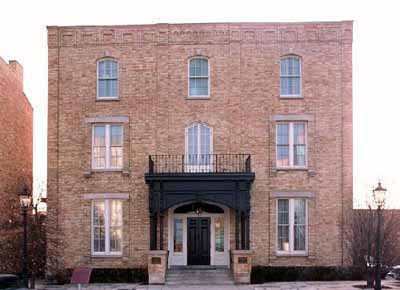Ridout Street Complex National Historic Site of Canada
London, Ontario

General view
© Parks Canada Agency / Agence Parcs Canada.
Address :
435, 441-447, and 451 Ridout Street North, London, Ontario
Recognition Statute:
Historic Sites and Monuments Act (R.S.C., 1985, c. H-4)
Designation Date:
1966-10-26
Dates:
-
1838 to 1870
(Construction)
-
1838 to 1870
(Significant)
Event, Person, Organization:
-
Dr. Alexander Anderson
(Person)
-
William Weld
(Person)
Other Name(s):
-
Ridout Street Complex
(Designation Name)
Research Report Number:
1966-043, 2004-SDC/CDE-020
Plaque(s)
This streetscape includes several of London's earliest buildings and provides a capsule view of the appearance of mid-19th century Ontario cities. These buildings, the earliest of which was begun in 1835, include residential, industrial and commercial premises all intermingled on one of the city's main streets. This group of structures soon became known as "Banker's Row" because of the presence of five branch offices here. After years of neglect and deterioration, they were threatened until John Labatt Limited, in a move to preserve this rich heritage, restored three structures.
Description of Historic Place
The Ridout Street Complex National Historic Site of Canada, is located in downtown London, Ontario, at the confluence of the north and south branches of the River Thames. The complex is comprised of a row of three distinguished, mid-19th-century residential and commercial buildings, the Anderson Residence, the Bank of Upper Canada building and the Gore Bank of Canada building. Their forms, materials, and details provide unity to the group, while their individual treatments and separate structures provide a varied streetscape. The designation refers to the three buildings at 435, 441-447, and 451 Ridout Street North on their footprints as they existed at the time of designation (1966).
Heritage Value
Ridout Street Complex was designated a national historic site of Canada in 1966 because: it provides a capsule view of the appearance of mid-19th century Ontario cities; and, it includes several of London’s earliest residential and commercial buildings.
The heritage value of this site resides in the grouping of these representative examples of mid-19th-century urban architecture in southwestern Ontario. Ridout Street North was London’s first financial district, where leaders in the fields of law, medicine, and finance established offices and homes. The street came to be known as ‘Banker’s Row’ after the establishment of the head offices of five banks, which were later turned into residences or business premises. The conservative classicized forms and the use of locally made buff-coloured brick are typical of the buildings in this area during the late 19th century.
Sources: Historic Sites and Monuments Board of Canada, Minutes, October 1966, June 2004.
Character-Defining Elements
Key elements contributing to the heritage value of the site include: its location in downtown London, Ontario near the River Thames; the spatial relationship of the individual buildings, close to one another and to the street; the classically-inspired design evident in the refined proportions, rectangular massing, symmetry and restrained detailing of all three buildings; the brick and timber construction; the consistent exterior use of local buff-coloured brick; the symmetrically arranged façades with regular placement of multi-paned, double-hung windows; viewscapes on the complex as a whole from surrounding streets.
Key elements contributing to the heritage value of the Anderson Residence (No. 451) in the Ridout Complex include: its monumental rectangular three-storey massing under a flat roof with a slight pitch to the rear and four end chimneys; its Tudor-arched central doorway with sidelights, transom and paired double-hung windows framed by a brick surround, under a projecting portico; its range of segmental headed windows on the third floor exterior surmounted by a decorative brick frieze; any evidence of its original interior plan; any surviving original interior detailing, furnishing and fittings, including: shutters, door and window trim, ceiling mouldings, cornices, mantelpieces, fireplaces, columns and brackets.
Key elements contributing to the heritage value of the Gore Bank (Nos. 441-447) in the Ridout Complex include: its three-storey massing as one integral structure split along the line of a carriageway approximately one third of the distance from the south end; the semi-elliptical carriageway entrance and the double hung windows corresponding with the openings adjacent to the carriageway; the placement and integrity of the chimneys, set above the bold cornice; any surviving original interior features, including: mouldings, pilasters, panelled doors, balustrades, railings.
Key elements contributing to the heritage value of The Bank of Upper Canada (No. 435) in the Ridout Complex include: its two-storey rectangular massing under a low-pitched gable roof with two end chimneys, plainly detailed eaves and side façades forming parapets; its six-paneled central doorway with sidelights and an elaborate semi-elliptical fanlight; any surviving original interior features that are associated with the heritage value of the complex, including quirk trim and corner blocks, mantelpieces, staircases, and fireplaces.